2013 Peugeot 508 Hybrid warning
[x] Cancel search: warningPage 171 of 340
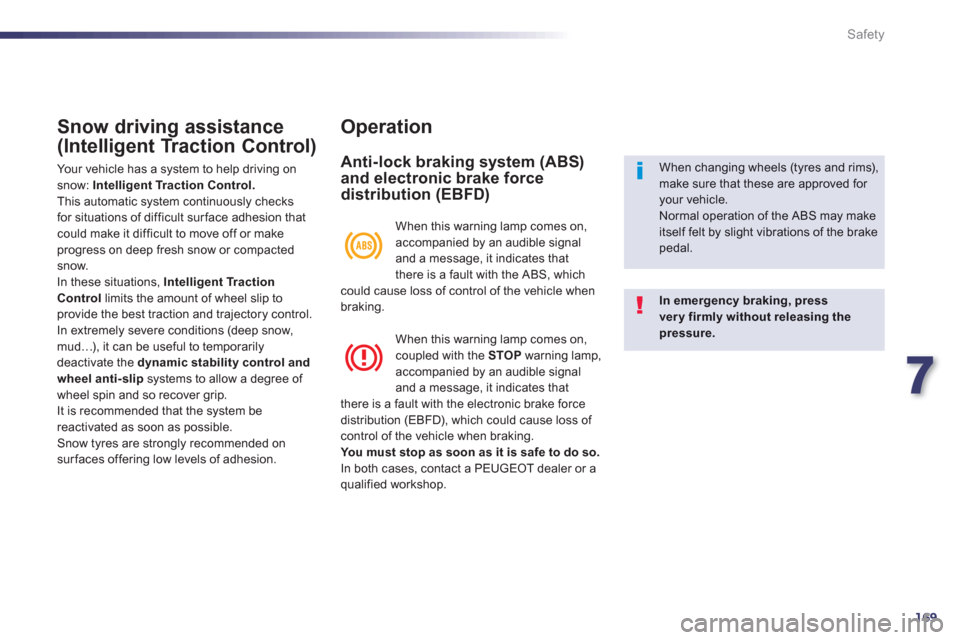
7
169
Safety
Snow driving assistance
(Intelligent Traction Control)
Your vehicle has a system to help driving on snow: Intelligent Traction Control. This automatic system continuously checks for situations of difficult surface adhesion thatcould make it difficult to move off or makeprogress on deep fresh snow or compacted snow.
In these situations, Intelligent Traction
Controllimits the amount of wheel slip to provide the best traction and trajectory control.
In extremely severe conditions (deep snow,mud…), it can be useful to temporarilydeactivate the dynamic stability control andwheel anti-slip
systems to allow a degree of
wheel spin and so recover grip.
It is recommended that the system be
reactivated as soon as possible.
Snow t
yres are strongly recommended on sur faces offering low levels of adhesion.
Operation
Anti-lock braking system (ABS)and electronic brake force
distribution (EBFD)
In emergency braking, press very firmly without releasing the pressure.
When changing wheels (tyres and rims),make sure that these are approved for your vehicle.
Normal operation of the ABS may makeitself felt by slight vibrations of the brake pedal. When this warnin
g lamp comes on,
accompanied by an audible signal
and a message, it indicates that
there is a fault with the ABS, which could cause loss of control of the vehicle whenbraking.
When this warnin
g lamp comes on,coupled with the STOPwarning lamp,
accompanied by an audible signaland a message, it indicates that
there is a fault with the electronic brake forcedistribution (EBFD), which could cause loss of control of the vehicle when braking.
You must stop as soon as it is safe to do so.In both cases, contact a PEUGEOT dealer or a qualified workshop.
Page 172 of 340
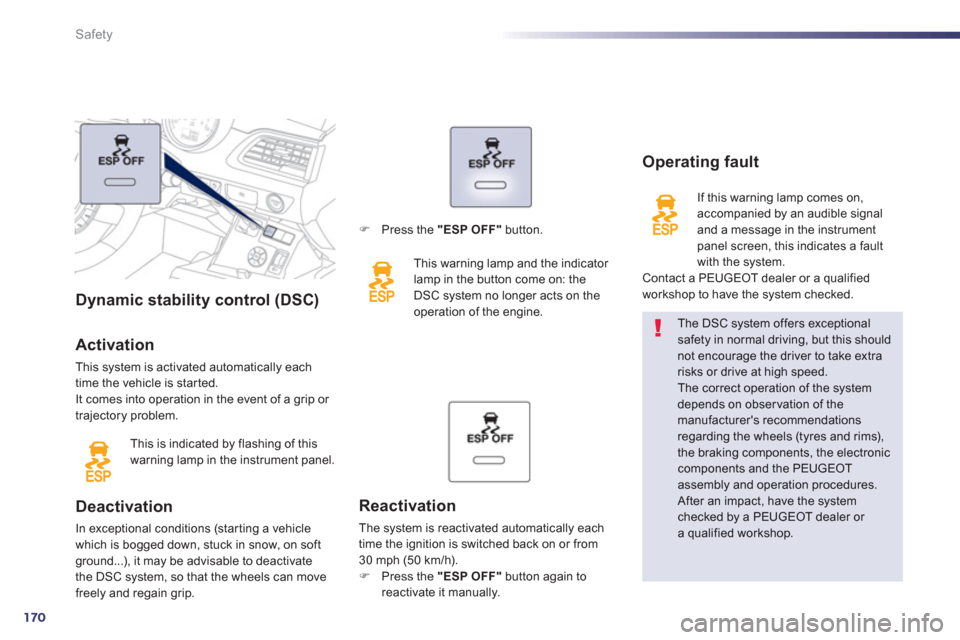
170
Safety
Dynamic stability control (DSC)
Activation
This system is activated automatically each
time the vehicle is started.
It comes into operation in the event of a grip or
trajectory problem.
This is indicated b
y flashing of this
warning lamp in the instrument panel.
Deactivation
In exceptional conditions (starting a vehicle
which is bogged down, stuck in snow, on softground...), it may be advisable to deactivate
the DSC system, so that the wheels can move
freely and regain grip.
The DSC system offers exceptional safety in normal driving, but this should not encourage the driver to take extra risks or drive at high speed.
The correct operation of the system depends on obser vation of the manufacturer's recommendationsregarding the wheels (tyres and rims),the braking components, the electronic components and the PEUGEOTassembly and operation procedures.
After an impact, have the systemchecked by a PEUGEOT dealer or a qualified workshop.
Operating fault
If this warning lamp comes on,
accompanied by an audible signal
and a messa
ge in the instrument
panel screen, this indicates a fault
with the system.
Contact a PEUGEOT dealer or a qualified
workshop to have the system checked.
Reactivation
The system is reactivated automatically eachtime the ignition is switched back on or from
30 mph (50 km/h).F Press the "ESP OFF"
button again to
reactivate it manually.
F Press the "ESP OFF"
button.
This warnin
g lamp and the indicator
lamp in the button come on: the
D
SC system no longer acts on the
operation of the engine.
Page 174 of 340
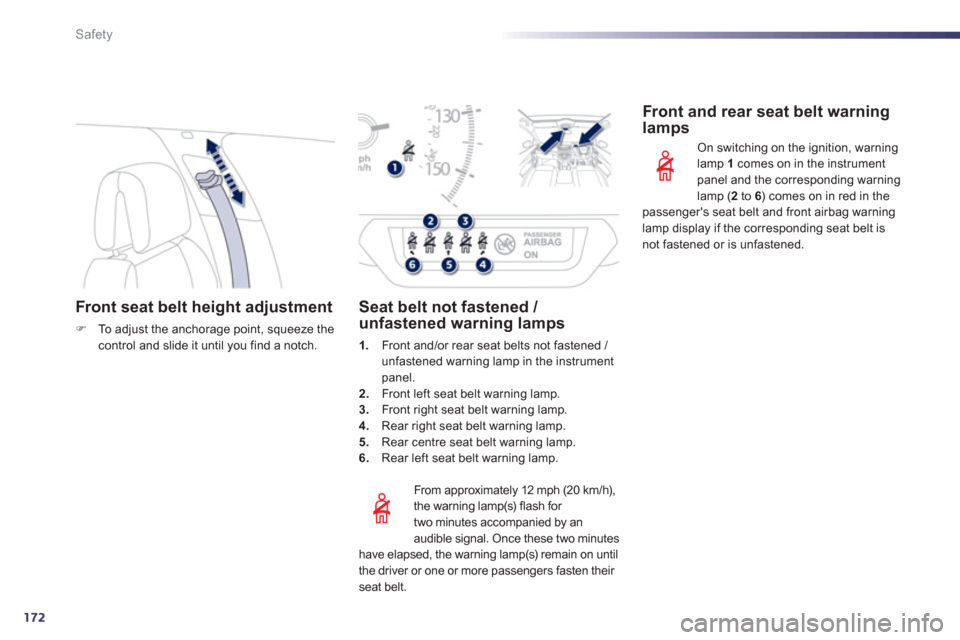
172
Safety
Front seat belt height adjustment
FTo a djust the anchorage point, squeeze thecontrol and slide it until you find a notch.
From approximatel
y 12 mph (20 km/h),
the warning lamp(s) flash for
two minutes accompanied by an
audible si
gnal. Once these two minutes
have elapsed, the warning lamp(s) remain on until
the driver or one or more passengers fasten their seat belt.
Seat belt not fastened / unfastened warning lamps
1.Front and/or rear seat belts not fastened / unfastened warning lamp in the instrument
panel.
2. Front left seat belt warning lamp.3.
Front right seat belt warning lamp.4.Rear right seat belt warning lamp.
5.Rear centre seat belt warning lamp.
6. Rear left seat belt warning lamp.
Front and rear seat belt warning lamps
On switching on the ignition, warninglamp 1
comes on in the instrument
panel and the corresponding warning lamp (2 to 6) comes on in red in thepassenger's seat belt and front airbag warninglamp display if the corresponding seat belt isnot fastened or is unfastened.
Page 175 of 340
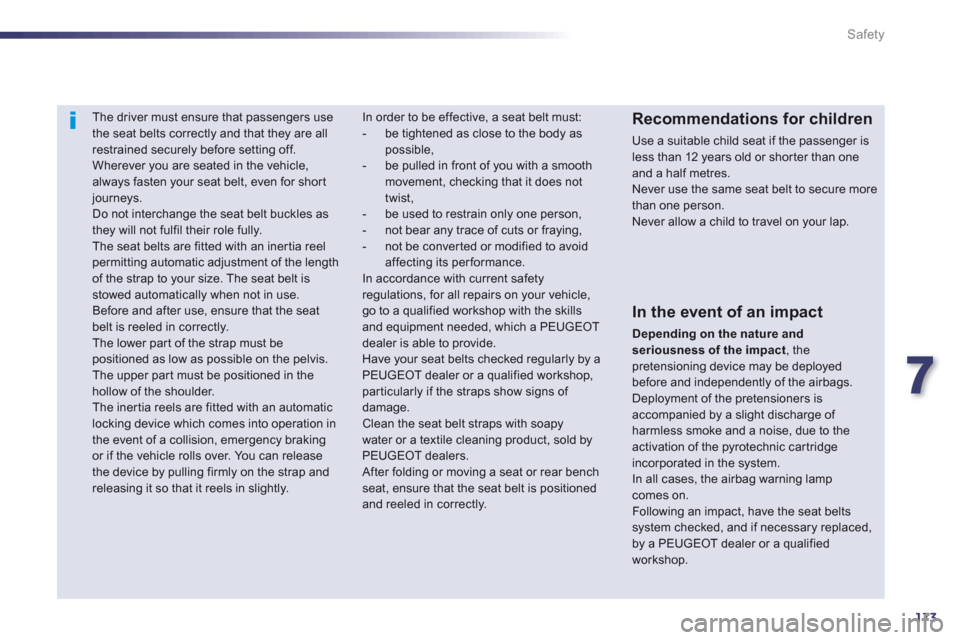
7
173
Safety
The driver must ensure that passengers usethe seat belts correctly and that they are allrestrained securely before setting off.
Wherever you are seated in the vehicle, always fasten your seat belt, even for short journeys.
Do not interchange the seat belt buckles asthey will not fulfil their role fully.
The seat belts are fitted with an inertia reel permitting automatic adjustment of the length of the strap to your size. The seat belt isstowed automatically when not in use.
Before and after use, ensure that the seatbelt is reeled in correctly.
The lower par t of the strap must bepositioned as low as possible on the pelvis.
The upper par t must be positioned in the hollow of the shoulder.
The inertia reels are fitted with an automatic locking device which comes into operation inthe event of a collision, emergency braking or if the vehicle rolls over. You can releasethe device by pulling firmly on the strap and releasing it so that it reels in slightly.
Recommendations for children
Use a suitable child seat if the passenger isless than 12 years old or shor ter than one
and a half metres. Never use the same seat belt to secure morethan one person. Never allow a child to travel on your lap.
In order to be effective, a seat belt must:
- be tightened as close to the body as possible,
- be pulled in front of you with a smooth movement, checking that it does nottwist,
- be used to restrain only one person,
- not bear any trace of cuts or fraying,
- not be converted or modified to avoid affecting its per formance.
In accordance with current safety regulations, for all repairs on your vehicle, go to a qualified workshop with the skills and equipment needed, which a PEUGEOT dealer is able to provide.
Have your seat belts checked regularly by a PEUGEOT dealer or a qualified workshop, particularly if the straps show signs of damage.
Clean the seat belt straps with soapywater or a textile cleaning product, sold by PEUGEOT dealers.
After folding or moving a seat or rear bench seat, ensure that the seat belt is positioned and reeled in correctly.
In the event of an impact
Depending on the nature and seriousness of the impact
, thepretensioning device may be deployedbefore and independently of the airbags.Deployment of the pretensioners isaccompanied by a slight discharge of harmless smoke and a noise, due to theactivation of the pyrotechnic cartridgeincorporated in the system.In all cases, the airbag warning lampcomes on.Following an impact, have the seat belts system checked, and if necessary replaced,by a PEUGEOT dealer or a qualified workshop.
Page 177 of 340
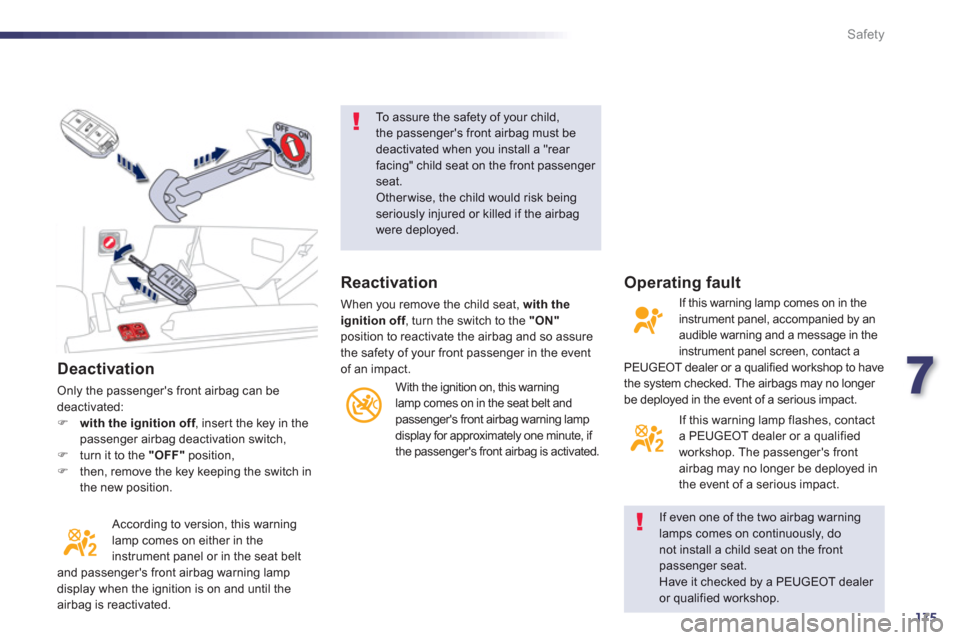
7
175
Safety
Deactivation
Only the passenger's front airbag can be deactivated:Fwith the ignition off, inser t the key in thefpassenger airbag deactivation switch, F
turn it to the "OFF"position, F
then, remove the key keeping the switch in
the new position.
According to version, this warning lamp comes on either in the instrument panel or in the seat belt
and passenger's front airbag warning lamp
displa
y when the ignition is on and until the
airbag is reactivated.
To assure the safety of your child,the passenger's front airbag must be deactivated when you install a "rear facing" child seat on the front passenger seat.Other wise, the child would risk beingseriously injured or killed if the airbag were deployed.
If even one of the two airbag warning
lamps comes on continuously, donot install a child seat on the frontpassenger seat.
Have it checked by a PEUGEOT dealer or qualified workshop.
Reactivation
When you remove the child seat, with the ignitionoff
, turn the switch to the f"ON"position to reactivate the airbag and so assure
the safety of your front passenger in the event
of an impact.
With the ignition on, this warninglamp comes on in the seat belt and
passenger's front airbag warning lamp
displa
y for approximately one minute, if
the passenger's front airbag is activated.
Operating fault
If this warning lamp comes on in theinstrument panel, accompanied by an audible warning and a message in the
instrument panel screen, contact a
PEUGEOT dealer or a qualified workshop to have
the system checked. The airbags may no longer
be deployed in the event of a serious impact.
If this warnin
g lamp flashes, contacta PEUGEOT dealer or a qualified
workshop. The passenger's front airbag may no longer be deployed in
the event of a serious impact.
Page 183 of 340
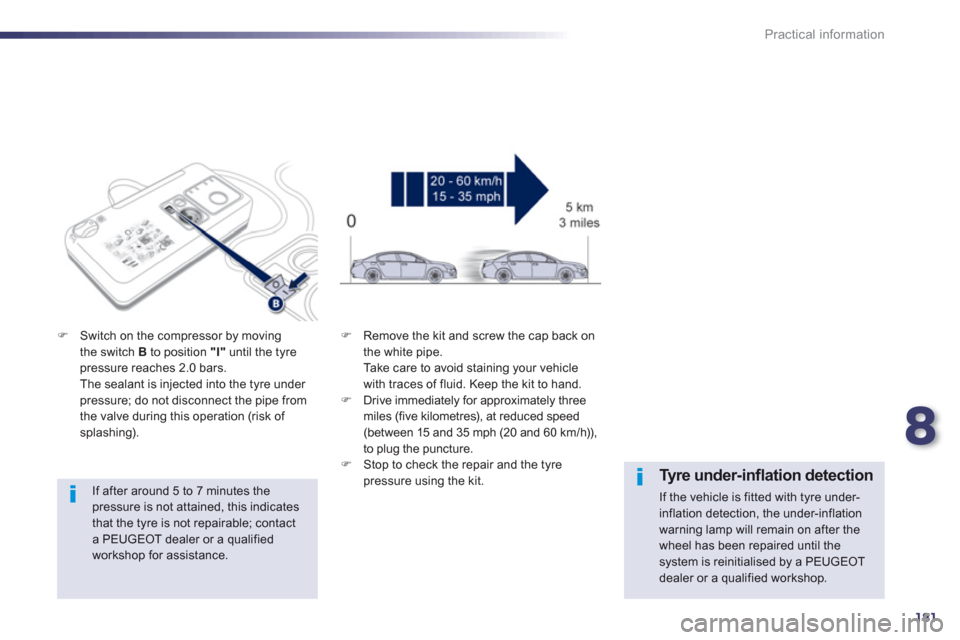
8
181
Practical information
If after around 5 to 7 minutes the pressure is not attained, this indicates that the tyre is not repairable; contacta PEUGEOT dealer or a qualifiedworkshop for assistance.
F
Switch on the compressor by moving
the switch B
to position "I"until the tyre pressure reaches 2.0 bars.
The sealant is injected into the tyre under pressure; do not disconnect the pipe from
the valve during this operation (risk of splashing).FRemove the kit and screw the ca
p back on
the white pipe.
Take care to avoid stainin
g your vehicle
with traces of fluid. Keep the kit to hand.
FDrive immediately for approximately three
miles (five kilometres), at reduced speed(between 15 and 35 mph (20 and 60 km/h)),
to plug the puncture.
FStop to check the repair and the tyre
pressure using the kit.
Tyre under-infl ation detection
If the vehicle is fitted with tyre under-inflation detection, the under-inflation warning lamp will remain on after thewheel has been repaired until thesystem is reinitialised by a PEUGEOT dealer or a qualified workshop.
Page 189 of 340

8
187
Practical information
Removing a wheel
Parking the vehicle
Immobilise the vehicle where it does notblock traffic: the ground must be level, stable and not slippery. Apply the parking brake unless it has
been programmed to automatic mode, switch off the ignition and engage firstgear *
to block the wheels.
Check that the braking warning lamp and the Pwarning lamp in the parkingbrake control lever come on.
The occupants must get out of the vehicle and wait where they are safe. Never go underneath a vehicle raised using a jack; use an axle stand.
List of operations
FRemove the bolt cover from each of
the bolts using the tool 3(according toequipment). FFit the security socket 4on the wheelbrace 1to slacken the security bolt (if fitted). FSlacken the other bolts using the
wheelbrace 1 only.
*
P
osition Rfor the electronic gear controlgearbox; Pfor the automatic gearbox.
Page 211 of 340
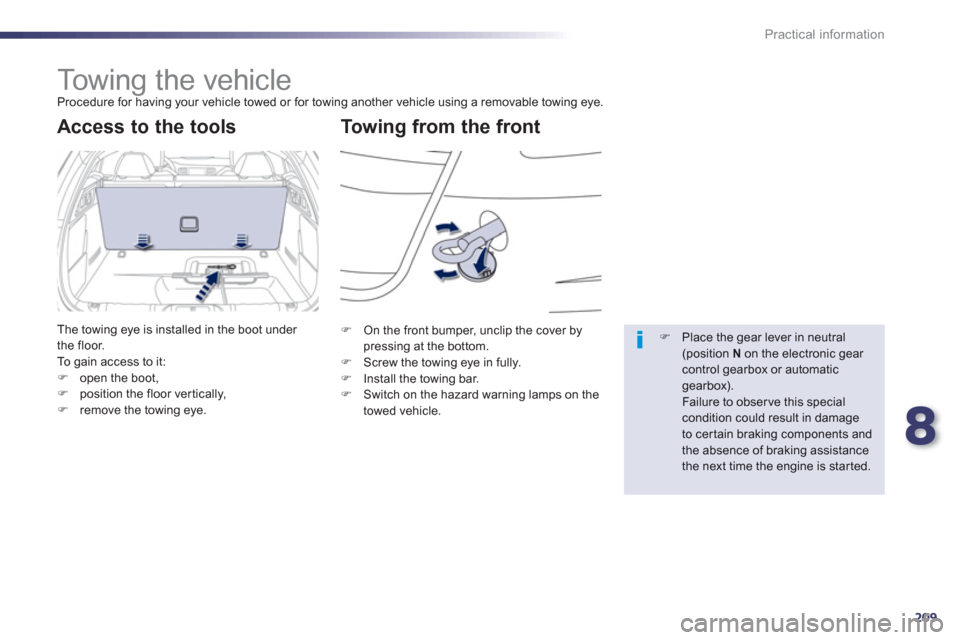
8
209
Practical information
Towing the vehicle
Procedure for having your vehicle towed or for towing another vehicle using a removable towing eye.
To w i ng from the front Access to the tools
The towing eye is installed in the boot under
the floor.
To gain access to it: F
open the boot, F
position the floor vertically,F
remove the towing eye.F
On the front bumper, unclip the cover by
pressing at the bottom.FScrew the towing eye in fully.FInstall the towing bar.FSwitch on the hazard warning lamps on the
towed vehicle.
F Place the gear lever in neutral (position Non the electronic gear control gearbox or automaticgearbox). Failure to obser ve this specialcondition could result in damage to cer tain braking components andthe absence of braking assistance the next time the engine is started.